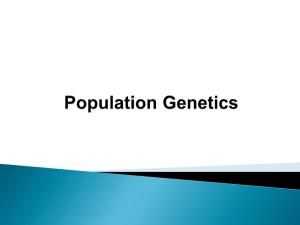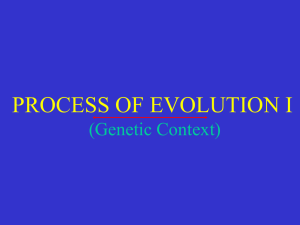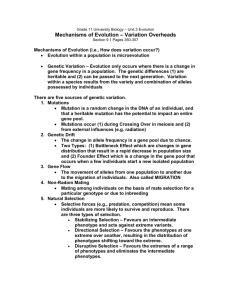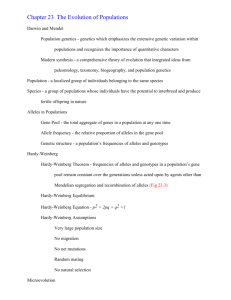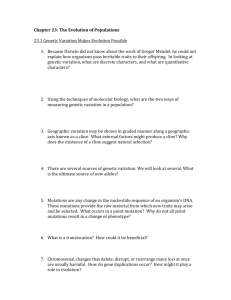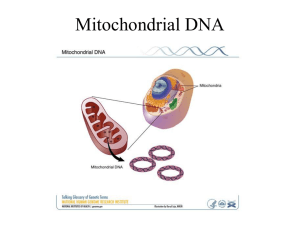Evolution of Populations
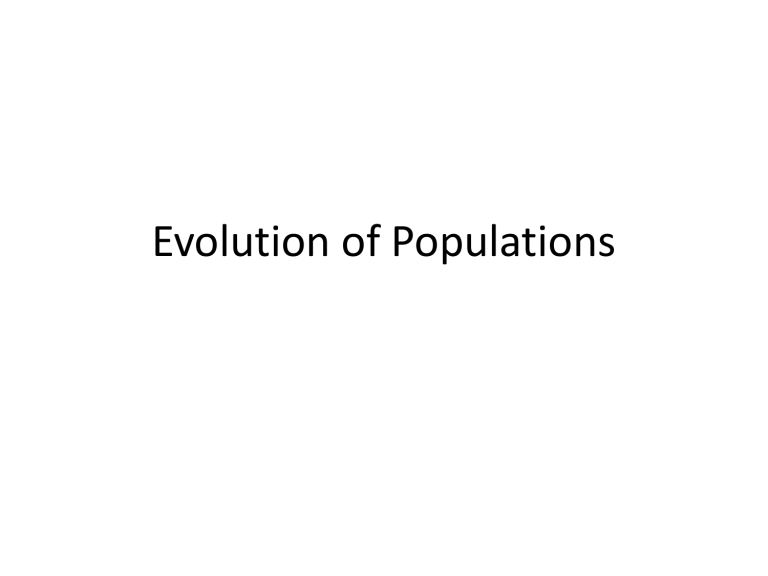
Evolution of Populations
The Smallest Unit of Evolution
• Natural selection acts on individuals, but only populations evolve
– Genetic variations contribute to evolution
Population genetics
• Population genetics
– study of how populations change genetically over time
• Mendelian genetics with the Darwinian theory
• populations as units of evolution
Gene Pools and Allele Frequencies
• Population
• localized group of individuals capable of interbreeding and producing fertile offspring
• gene pool
– total aggregate of genes in a population at any one time
– all gene loci in all individuals of the population
The Hardy-Weinberg Theorem
• population that is not evolving
• frequencies of alleles and genotypes in a population’s gene pool remain constant from generation to generation, provided that only
Mendelian segregation and recombination of alleles are at work
• preservation of genetic variation in a population
Hardy-Weinberg Equilibrium
• The five conditions for non-evolving populations are rarely met in nature:
– Extremely large population size
– No gene flow
– No mutations
– Random mating
– No natural selection
Hardy-Weinberg Equilibrium
• If p and q represent the relative frequencies of the only two possible alleles in a population at a particular locus, then
– p 2 + 2pq + q 2 = 1
– And p 2 and q 2 represent the frequencies of the homozygous genotypes and 2pq represents the frequency of the heterozygous genotype
LE 23-4
Generation
1
X
C R C R genotype
Plants mate
C W C W genotype
Generation
2
All C R C W
(all pink flowers)
50% C R gametes
50% C W gametes come together at random
Generation
3
25% C R C R 50% C R C W 25% C W C W
50% C R gametes
50% C W gametes come together at random
Generation
4
25% C R C R 50% C R C W 25% C W C W
Alleles segregate, and subsequent generations also have three types of flowers in the same proportions
Evolutionary Change
• Three major factors alter allele frequencies and bring about most evolutionary change:
– Mutations
– Natural selection
– Nonrandom Mating
– Genetic drift
– Gene flow
Variations that make Natural Selection Possible
• Mutation
– changes in the nucleotide sequence of DNA
– new genes and alleles to arise
– Point Mutations
• change in one base in a gene
• usually harmless
• may impact on phenotype
Mutations
• Chromosomal mutations that delete, disrupt, or rearrange many loci are typically harmful
• Gene duplication is nearly always harmful
Natural Selection
• Differential success in reproduction results in certain alleles being passed to the next generation in greater proportions
• 3 conditions for natural selection to occur and to result in evolutionary change
1. Variation must exist among individuals in a population
2. Variation among individuals must result in differences in the number of offspring surviving in the next generation
3. Variation must be genetically inherited
14
Sexual Recombination
• far more important than mutation
• produces the genetic differences that make adaptation possible
• Nonrandom mating
– Assortative mating
• Phenotypically similar individuals mate
• Increases proportion of homozygous individuals
– Disassortative mating
• Phenotypically different individuals mate
• Produces excess of heterozygotes
Genetic Drift
• The smaller a sample, the greater the chance of deviation from a predicted result
• allele frequencies fluctuate unpredictably from one generation to the next
• reduces genetic variation through losses of alleles
Genetic Drift
• The Bottleneck Effect
– sudden change in the environment that may drastically reduce the size of a population
– gene pool may no longer be reflective of the original population’s gene pool
Genetic Drift
• The Founder Effect
– a few individuals become isolated from a larger population
– affects allele frequencies
Gene Flow
• genetic additions or subtractions from a population, resulting from movement of fertile individuals or gametes
• gain or loss of alleles
• reduce differences between populations over time
A Closer Look at Natural Selection
• From the range of variations available in a population, natural selection increases frequencies of certain genotypes, fitting organisms to their environment over generations
Evolutionary Fitness
• Misleading
– “struggle for existence”
– “survival of the fittest”
• Fitness
– contribution an individual makes to the gene pool of the next generation, relative to the contributions of other individuals
• Relative fitness
– contribution of a genotype to the next generation, compared with contributions of alternative genotypes for the same locus
Directional, Disruptive, and Stabilizing Selection
• Selection favors certain genotypes by acting on the phenotypes of certain organisms
• Three modes of selection:
– Directional
• favors individuals at one end of the phenotypic range
– Disruptive
• favors individuals at both extremes of the phenotypic range
– Stabilizing
• favors intermediate variants and acts against extreme phenotypes
The Preservation of Genetic Variation
• Diploidy
– maintains genetic variation in the form of hidden recessive alleles
• Balancing selection
– natural selection maintains stable frequencies of two or more phenotypic forms
• Heterozygote Advantage
– Some individuals who are heterozygous at a particular locus have greater fitness than homozygotes
– Natural selection will tend to maintain two or more alleles at that locus
– Sickle cell and malaria
• Sexual selection
– natural selection for mating success
– sexual dimorphism
• differences between the sexes in secondary sexual characteristics
• Intrasexual selection
– competition among individuals of one sex for mates of the opposite sex
• Intersexual selection
– individuals of one sex (usually females) are choosy in selecting their mates from individuals of the other sex
Why Natural Selection Cannot Fashion
Perfect Organisms
• Evolution is limited by historical constraints
• Adaptations are often compromises
• Chance and natural selection interact
• Selection can only edit existing variations

